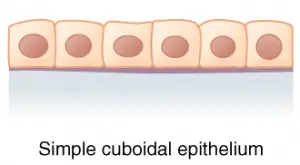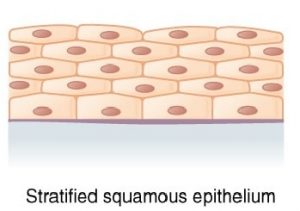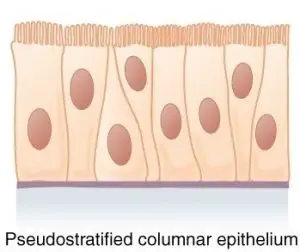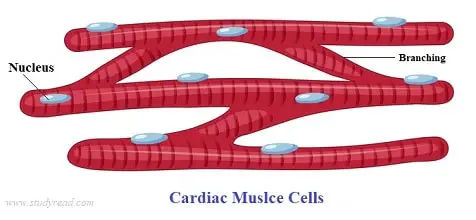A “tissue” in simple terms is a bunch of similar cells. The human body is basically made of four different types of tissues.
Types of tissues
- Epithelial tissue
- Connective tissue
- Muscular tissue
- Nervous tissue.
These tissues are made of similar cells to have the same physiological function in the body.
Every type of tissue mentioned has the same set of functions in almost all of the higher animals.
These tissues together form the organs in the body.
They serve many purposes in the body and are differentiated to carry out special physiological functions.
Based on their physical structure and function, tissues of the body are differentiated as
Epithelial tissue
- This tissue is the uppermost tissue covering all the organs or bodies.
- It is based on need, is of different types as simple epithelium, squamous epithelium, columnar epithelium, etc.
This is further classified as
- Simple epithelium
- Stratified epithelium.
Simple epithelium
This epithelium is a single layer of identical cells. It is present at sites of secretion, absorption, or diffusion of substances.
This epithelium is thin and offers the least resistance for the transfer of molecules from one side to another. Hence, it is absent on the surfaces exposed to stress.
Based on the shape of cells in this layer, it is further differentiated as
- Squamous epithelium,
- Cuboidal epithelium
- Columnar epithelium.
Types of simple epithelium tissues:
Simple squamous epithelium

This is a single layer of flattened cells that are closely fitted to each other like tiles on the floor. The surface is smooth and thin, due to which substances can diffuse easily. It is present as linings of organs like the
- Lungs-alveoli
- Blood vessels-endothelium
- Heart as endocardium.
- Kidney collecting ducts-linings.
2. Simple cuboidal epithelium
It has a single layer of closely fit cuboid-shaped cells. Due to the size of the cells, we can predict that they play a certain role in physiology. They are involved in functions like secretion, absorption, and excretion, etc.
They are found in tubules of nephrons and glands.

3. Simple columnar epithelium
This has a single layer of rectangle-shaped cells that appear as long columns. They are involved in functions like secretions, absorption, and expulsion.
They are found in the inner layers of the stomach, intestine, trachea, etc.
In the intestine, they are modified to have microvilli on their free end to help in the absorption of digested nutrients. In the trachea, they have cilia on their free surface. This cilium moves the mucus towards the throat.

Stratified epithelium (multiple layers of cells)
In this epithelium, the cells are arranged multiple layers.
The cells in the lower layers continually divide, pushing those in the upper layers towards the surface.
The shape of the cells varies in different layers. The cells of the lower layers are thick, while those of the upper layers near the surface are flat.
Further, the upper layer cells might be keratinized, and dehydrated to protect from heat, microbes, wear and tear, chemicals, etc. This type of layer is seen in the skin.
In most other types of stratified epithelium, the upper layer is non-keratinized.
Based on the shape of lower layer cells, the epithelium is again differentiated as stratified squamous epithelium, stratified cuboidal epithelium, columnar stratified epithelium, and pseudostratified columnar epithelium.
There is another type called the transitional epithelium. This type of tissue is present in the urinary bladder. Cells are cuboidal or columnar in a relaxed state. But when there is load, they stretch and become flat to accommodate the substance (urine).
There is one more type of epithelium, i.e., glandular epithelium which is present in glands.
Types of Stratified epithelium tissues:
1. Stratified squamous epithelium
This has squamous-shaped cells arranged in multiple layers.

2. Stratified cuboidal epithelium
It has cuboidal-shaped cells in multiple layers.

3. Stratified columnar epithelium
In this epithelium, the column-shaped cells are in layers.

4. Psuedo-stratified columnar epithelium: Single layer of columnar-shaped cells arranged in such a way to give a false impression of multiplayer.

Connective tissue
This tissue, as the name indicates, connects other tissues.
It is the most abundant tissue of all the other tissues.
The cells in these tissues are widely dispersed from each other in a matrix (substance) that has fibers.
These fibers hold the cells together and support the whole tissue.
These tissues can be very hard, loose like a liquid, and even semisolid.
The tissue consists of cells like fibroblasts, fat cells, macrophages, leukocytes, plasma cells, and mast cells.
Their main role in the body is to
- Protect
- Transport and
- Give Binding support
These are of many types, such as adipose tissues, reticular tissue, etc.
This connective tissue is of different types, as
- Loose connective tissue. (Areolar tissue, adipose tissue)
- Lymphoid tissue
- Dense connective tissue.
- Cartilage tissue
- Bone tissue
- Blood – Liquid connective tissue (W.B.C’s, lymph)
The connective tissue has different types of cells supporting specialized tissue. These cells include fibroblasts, fat cells, mast cells, and also white blood cells like macrophages, plasma cells, etc.
Loose areolar connective tissue
It is a widely distributed connective tissue. It is made of fibroblasts, mast cells, macrophages, and fat cells. It provides elasticity and tensile strength to almost all the parts of the body.
It supports and connects other tissues like below the skin, between the muscles in the digestive tract, glands, etc.
Adipose tissue
This tissue consists of adipocytes (also called fat cells) with fat globules in the matrix of areolar tissue. This tissue is of two types as
a) White adipose tissue
b) Brown adipose tissue.
White adipose tissue makes up to 25% of body weight in healthy adults. It acts as a thermal insulator and also an energy store.
It also supports the kidneys, eyes, muscles, and skin.
Brown adipose tissue is found in newborns and in very small amounts in adults. It helps in the maintenance of body temperature with the ability to produce more heat than energy.
Lymphoid tissue
This tissue is found in lymph nodes and organs of the lymphatic system. It has a semisolid consistency and consists of reticular cells, monocytes, and lymphocytes.
Dense connective tissue
Unlike the loose connective tissue, this has more fibers and fewer cells. This is further differentiated as
a) Fibrous tissue
b) Elastic tissue
Fibrous tissue
It has collagen fibers and fewer fibroblasts. It forms ligaments of bone joints, tendons for skeletal muscle to fix to the bone, and also as a protective cover to the bones, brain, and kidney.
Elastic tissue
As the name indicates, it is highly elastic with an ability to recoil after extension.
It has elastic fibers in its matrix and is found in the lungs, trachea, bronchi, and the walls of large blood vessels.
Blood
Blood is called a liquid connective tissue. It is composed of blood cells (45%) and plasma (55%). The blood cells include
- Red blood cells,
- White blood cells and
- Platelets.
The plasma consists of 90% water, and the remaining includes
- Plasma proteins like albumin, globulin
- Gases
- Electrolytes (Sodium, potassium, magnesium, calcium, etc)
- Nutrients like glucose, amino acids, lipids
- Hormones, enzymes
- waste materials for excretion
- Clotting factors
Blood function includes:
- Supply of oxygen and nutrients to all the body.
- Excretion of waste,
- Defense against disease-causing pathogens
- Maintenance of uniform temperature
Cartilage
It is harder and stronger than prior tissue types. It is made up of cells called chondrocytes, which are embedded in a matrix of collagen and elastic fibers. This cartilage is of three types as
a) Hyaline cartilage
b) Elastic cartilage
c) fibrocartilage
Bone tissue
This is formed by osteocytes (bone cells) along with wth collagen fibers and inorganic salts like phosphate and calcium.
Muscular tissue
As the name indicates, these tissues make muscles of the body. This tissue is of 3 types as
- Skeletal muscle tissue
- Cardiac tissue
- Smooth muscle tissue
Skeletal muscle (striated muscles)

This tissue is attached to the body’s skeletal system, especially long bones. They also have bands or striations along the length. They are voluntary i.e. they are under the control of our will. They help in moving from one place to another.
Cardiac muscles

As the name indicates, these are present in the heart. They like skeletal muscles that have striations in them. But the difference is that they have branches. This muscle helps to pump blood by the heart.
Smooth muscles

They are spindle or cone-shaped in structure. They help in the contraction and relaxation of organs like the lungs, stomach, uterus, etc.
They help in movement, contraction, and other physiological activities. They are involuntary. The brain controls them.
Nervous tissue
This tissue is present primarily in the entire nervous system, including the brain and spinal cord. It has two types of tissue: nerve cells and neuroglia.
The nerve cells are the longest cells in the body.
They can be up to a few meters. They transmit impulses from the brain to other body parts and vice-versa.
This tissue controls the whole body by conducting impulses across the body.
The tissue operates by the use of bio-molecular chemical substances called neurotransmitters.
Neuroglial tissue is a binding tissue around the neurons.
It helps to protect the nerve cells from damage.
Unlike other cells, these cells do not multiply.
They are formed during birth and last till death.
If there is any damage to them in between, it can lead to the loss of their function forever.
Reference:
Principles of Anatomy and Physiology.-Ross and Wilson


Good, comprehensive, and easy to understand.
As to the last section, Nervous tissue:
“They are formed during birth and last till death. “during gestation”?
If there is any damage to them in between, it can lead to the loss of their function forever.”
There are neuron stem cells that can repair the damage, and there are both neural and immune stem cells in the brain. The word, “can”, is correct, however.
What types of tissue are “stem” cells? Glial cells? Neurons?
Also, muscle cells are also “formed during birth and last till death” but are repaired by stem cells (called satellite cells and adult stem cells)
The Potential of Muscle Stem Cells
Hi Denis, thanks for the input. Also, the new nerve cells are formed in adult hippocampal regions for the most part of life.
I will update the info.
regards
After attempting to understand this topic for many weeks, I could not achieve clarity until I read this article. May it continue to teach people the mechanics of different types of tissues.
So simple language… Easily understable.. Thanks..
Thank u.this is helpful in my study and my life
very,very understandable!!
Thank you.
very understandable thank you
Thanks, I enjoy studying science..
This has given me clear understanding of tissue. Thanks.
Very good explanation of Tissues
thanks
Nice
This was helpful for my study giude i have a big test with 60 questions so thanks again
thank u
Well done!
thank you
Thanks
thanks
@ halema! You are welcome again..
yay